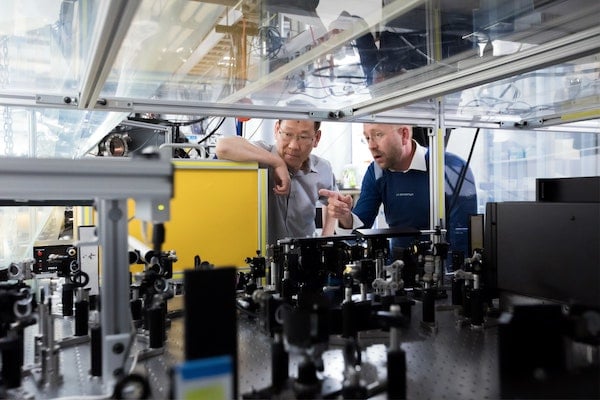Published on
How Continuing Education is Preparing Us For The Future of Work

With the steady and consistent advancement of technology—and its impact on the day-to-day functioning of every industry—employers need to be constantly aware of the need to upskill their employees. Postsecondary institutions have a responsibility to support employers and corporations facing this new paradigm, and continuing education divisions have historically managed this relationship. In this interview, Jason Wingard discusses what it takes for employers to adapt to the realities of the Future of Work, sharing his thoughts on how continuing education divisions can support the delivery of this vision.
The EvoLLLution (Evo): How do the education requirements of the Future of Work differ from the needs of the labor market past and present?
Jason Wingard (JW): When it comes to the educational requirements of the Future of Work, “adaptability” is the watchword and is a vital characteristic for employees to have for years to come. Today, job opportunities are more frequently tied to higher-level social or analytical skills. They’re often acquired through a traditional college degree or professional studies-focused curriculum, compared to the physical or manual skills that were prevalent even 30 years ago. High-level social and analytical skills are still needed, but the world of work will be further transformed by technology, automation, and the “gig” economy. Educational requirements will change too.
In order to thrive in the 2020s, employees will need to interface more frequently with machines, AI, and robots. With such enhancements, applied learning will take the lead in education. For example, career competencies such as communication, teamwork, and problem solving will remain important, but students will also need to learn to be adaptable in defining and refining those skills according to different sectors of work.
For employees to keep up with such changes, the old idea of a “three-stage life” (education, work, and retirement) must now change to a “multistage life” (several careers with multiple breaks to learn new skills).
Evo: What are a few of the gaps between the way most corporations approach employee education and the needs of the Future of Work?
JW: A significant gap I have witnessed involves employers needing to view employee education as a matter of acquisition and retention for the future of the firm.
Companies should provide a range of learning and development opportunities, such as coaching, mentorship, on-the-job training, and sponsored continuing education to reach their employees at all levels and career stages. This goal requires a little foresight — leadership needs to champion the changes coming in their own organizations and plan to upskill or reskill employees accordingly.
Amazon is a good example of this approach, since they will spend $700 million to retrain 100,000 employees by 2025. That’s a third of its workforce. The company couldn’t find enough workers who already had the skills they need, so they’re investing in the reskilling of employees at all levels to fit those needs.
These retraining initiatives are a good start, but it will take many stakeholders (government, higher education, etc.) working together to reach everyone.
Another gap is in the area of upskilling employees, who will likely stay in the same role, but need more technological skills. PwC recently announced a $3 billion investment to upskill employees by launching a “New world. New skills” initiative to develop technologies for supporting clients. This initiative helps identify skill gaps and helps employees building future-proof skill strategies. Such programs are integral to employee acquisition and retention. In a recent Robert Half survey I read, 91 percent of employees cite professional training as an important factor when choosing an employer.
Evo: How have continuing education divisions evolved to present day to help bridge some of those gaps?
JW: Higher education institutions need to fully embrace non-degree programs, such as alternative credentials and certifications, as an increasingly important offering for students and the labor market overall.
These credentials tend to focus on job-relevant skills and competencies, which educational providers develop jointly with employers. This partnership leads to a more market-responsive higher education institution that can evolve continuing education programs to meet the rapid changes in the marketplace.
At the Columbia University School of Professional Studies, we have a Business Certification Program, which is growing in popularity. Our school has over one hundred students a year earning their Advanced Graduate Certificate in Business or Certification of Professional Achievement in Business since we began offering these post-baccalaureate programs.
Over 90 percent of higher education institutions offer alternative credentials. While 64 percent see alternative credentialing as important to the future of continuing education, only 34 percent have a strategic plan for the programs. This gap needs to be addressed in order for continuing education divisions to stay competitive with the ever-changing labor market.
The appetite for such coursework and credentialing is high. About sixty-three percent of U.S. workers report that they have taken a professional class or training in the past year.
An expanded focus on alternative credentialing, non-degree programs, and competency-based education will serve continuing education divisions (and higher education more broadly) well in the coming years.
Evo: How must corporate education policies and processes evolve for companies to remain competitive and viable into the future?
JW: In order for corporations to survive and thrive in the future workplace, they must invest in someone to think specifically about their corporate education policies and processes. Ideally, this person would be a member of the C-Suite, in order to have the power to drive an agenda and make company-wide decisions.
This role should have a broad sense of the future of work variables (e.g. the multigenerational workforce and technological advancements) that would impact the organization. They should also pay close attention to the changing skills needed for their particular firm and sector of work, making appropriate learning opportunities available at all levels of the firm.
What this new role will be doing is future thinking, strategy, and alignment with talent and all this effort will be viewed through a learning lens. The Chief Learning Officer’s focus will differ from that of their Human Resources counterpart. While many company education policies currently encompass the time and thought of other leaders, such as the Chief Innovation Officer, this function should be the sole purpose of someone else.
Evo: How do you see the role of continuing education divisions evolving within this new paradigm to continue supporting employers and corporations?
JW: Continuing education divisions, or professional studies schools within universities, need to be agile, adaptable, and ready to respond to rapid changes in the labor market. In order to achieve this nimbleness, these institutions need to embrace the applied learning model, which is the concept of comprehending and applying learnings in real-world scenarios.
Center to applied learning is bringing real-time industry insights into the classroom from leaders on the front lines of their fields. This act ensures that skills and competency building is just-in-time to meet employer needs. Another success tactic higher education may consider is leveraging industry thought leaders as lecturers, versus staying to the traditional tenured professor approach.
Applied learning coordinated with employer needs supports career readiness for employees across the board. A great example of this notion is a recent partnership between the Columbia School of Professional Studies and Parity and Nasdaq.These organizations sponsored a Gender Diversity Innovation Challenge for School of Professional Studies students.
Students across disciplines were asked to measure gender diversity at the leadership level among universities and early-stage tech firms. They measured diversity and defined strategies with new technology to drive adoption of greater gender diversity within organizations. This applied learning expanded the students’ understanding of the most important career competencies and fulfilled a need for prospective employers.
Partnerships like this one are the future of continuing education divisions in serving the needs of both employers and employees going forward.
Author Perspective: Administrator



